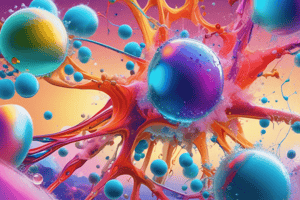Podcast
Questions and Answers
What is the main characteristic of particles in a solid?
What is the main characteristic of particles in a solid?
- They are arranged randomly.
- They move randomly at high speeds.
- They have large gaps between them.
- They vibrate in fixed positions. (correct)
Particles in a gas have strong forces of attraction between them.
Particles in a gas have strong forces of attraction between them.
False (B)
What happens to the particles of a solid when it melts?
What happens to the particles of a solid when it melts?
The particles gain speed and move around each other.
A liquid has particles that are mostly ______ with small gaps in between.
A liquid has particles that are mostly ______ with small gaps in between.
Match the following states of matter with their properties:
Match the following states of matter with their properties:
What is the first step in the freezing process?
What is the first step in the freezing process?
In the boiling process, particles overcome the forces of attraction between them.
In the boiling process, particles overcome the forces of attraction between them.
What happens to the particles during the evaporation process?
What happens to the particles during the evaporation process?
The process of converting a liquid into a solid is called ______.
The process of converting a liquid into a solid is called ______.
Match the phase change with its description:
Match the phase change with its description:
What process describes the direct change of a solid to a gas?
What process describes the direct change of a solid to a gas?
Deposition is the process where a gas changes directly into a solid.
Deposition is the process where a gas changes directly into a solid.
Which particles will spread out more quickly, those with a lower mass or those with a higher mass?
Which particles will spread out more quickly, those with a lower mass or those with a higher mass?
The reaction between ammonia (NH₃) and hydrochloric acid (HCl) produces __________.
The reaction between ammonia (NH₃) and hydrochloric acid (HCl) produces __________.
Match the following states of matter with their description:
Match the following states of matter with their description:
What happens to the solubility of a solute as the temperature increases?
What happens to the solubility of a solute as the temperature increases?
A saturated solution contains less solute than it potentially can hold at a given temperature.
A saturated solution contains less solute than it potentially can hold at a given temperature.
What is the term for the substance that dissolves in a solution?
What is the term for the substance that dissolves in a solution?
The formula for determining the maximum mass that will dissolve is: mass of water (g) * _______ (g per 100g) = maximum mass that will dissolve (g).
The formula for determining the maximum mass that will dissolve is: mass of water (g) * _______ (g per 100g) = maximum mass that will dissolve (g).
Match the following terms with their definitions:
Match the following terms with their definitions:
What is the primary purpose of simple distillation?
What is the primary purpose of simple distillation?
Fractional distillation can be used to separate liquids with similar boiling points.
Fractional distillation can be used to separate liquids with similar boiling points.
What is the role of the fractionating column in fractional distillation?
What is the role of the fractionating column in fractional distillation?
In chromatography, the value of retardation factor (Rf) is calculated using the formula Rf = $
rac{}{}$
In chromatography, the value of retardation factor (Rf) is calculated using the formula Rf = $ rac{}{}$
Match the following techniques with their applications:
Match the following techniques with their applications:
What is the charge of protons?
What is the charge of protons?
Isotopes of an element have the same number of neutrons?
Isotopes of an element have the same number of neutrons?
What is the atomic mass of an atom if it has 10 protons and 12 neutrons?
What is the atomic mass of an atom if it has 10 protons and 12 neutrons?
The term for the average mass of an atom is called __________.
The term for the average mass of an atom is called __________.
Match the following atomic components with their properties:
Match the following atomic components with their properties:
Which statement accurately describes a compound?
Which statement accurately describes a compound?
Mixtures can only be separated by chemical means.
Mixtures can only be separated by chemical means.
What is the substance left on the filter paper during filtration called?
What is the substance left on the filter paper during filtration called?
A ______ is a substance made up of one type of atom.
A ______ is a substance made up of one type of atom.
Match the separation method with its description:
Match the separation method with its description:
Which of the following properties is NOT associated with metals?
Which of the following properties is NOT associated with metals?
Non-metals are good conductors of heat.
Non-metals are good conductors of heat.
What charge do Group 1 ions carry?
What charge do Group 1 ions carry?
A substance that gains electrons will form a ______ ion.
A substance that gains electrons will form a ______ ion.
Match the group of ions with their corresponding charge:
Match the group of ions with their corresponding charge:
What characterizes noble gases?
What characterizes noble gases?
Metals are located on the right side of the periodic table.
Metals are located on the right side of the periodic table.
Write the electronic configuration for Magnesium (Mg).
Write the electronic configuration for Magnesium (Mg).
Group 7 elements are known as __________.
Group 7 elements are known as __________.
Match the following groups to their descriptions:
Match the following groups to their descriptions:
What type of bond is formed by the electrostatic attraction between positive and negative ions?
What type of bond is formed by the electrostatic attraction between positive and negative ions?
An anion is a positively charged ion.
An anion is a positively charged ion.
What is the charge of a sulfate ion?
What is the charge of a sulfate ion?
When an atom gains or loses electrons, it becomes an __________.
When an atom gains or loses electrons, it becomes an __________.
Match the following polyatomic ions with their formulas:
Match the following polyatomic ions with their formulas:
Flashcards
Solid state
Solid state
Particles are closely packed and vibrate in fixed positions.
Liquid state
Liquid state
Particles are close together but can move past each other, arranged randomly; less dense than solids.
Gas state
Gas state
Particles move randomly at high speeds and are far apart; almost no attraction.
Melting
Melting
Signup and view all the flashcards
Melting Point
Melting Point
Signup and view all the flashcards
Freezing
Freezing
Signup and view all the flashcards
Boiling Point
Boiling Point
Signup and view all the flashcards
Evaporation
Evaporation
Signup and view all the flashcards
Particle Movement (Freezing)
Particle Movement (Freezing)
Signup and view all the flashcards
Boiling
Boiling
Signup and view all the flashcards
Sublimation
Sublimation
Signup and view all the flashcards
Deposition
Deposition
Signup and view all the flashcards
Diffusion
Diffusion
Signup and view all the flashcards
Diffusion Speed & Mass
Diffusion Speed & Mass
Signup and view all the flashcards
Ammonia & Hydrochloric Acid
Ammonia & Hydrochloric Acid
Signup and view all the flashcards
Diffusion in Liquids
Diffusion in Liquids
Signup and view all the flashcards
Solute
Solute
Signup and view all the flashcards
Saturated Solution
Saturated Solution
Signup and view all the flashcards
Solubility
Solubility
Signup and view all the flashcards
Solubility Curve
Solubility Curve
Signup and view all the flashcards
Element
Element
Signup and view all the flashcards
Compound
Compound
Signup and view all the flashcards
Mixture
Mixture
Signup and view all the flashcards
Filtration
Filtration
Signup and view all the flashcards
Crystallization
Crystallization
Signup and view all the flashcards
Simple Distillation
Simple Distillation
Signup and view all the flashcards
Fractional Distillation
Fractional Distillation
Signup and view all the flashcards
Chromatography
Chromatography
Signup and view all the flashcards
Retardation Factor (Rf)
Retardation Factor (Rf)
Signup and view all the flashcards
How does chromatography separate components?
How does chromatography separate components?
Signup and view all the flashcards
Atom
Atom
Signup and view all the flashcards
Molecule
Molecule
Signup and view all the flashcards
Atomic Number
Atomic Number
Signup and view all the flashcards
Atomic Mass
Atomic Mass
Signup and view all the flashcards
Isotopes
Isotopes
Signup and view all the flashcards
What is the periodic table organized by?
What is the periodic table organized by?
Signup and view all the flashcards
Halogens
Halogens
Signup and view all the flashcards
Noble Gases
Noble Gases
Signup and view all the flashcards
Electronic Configuration
Electronic Configuration
Signup and view all the flashcards
Ionic Bonding
Ionic Bonding
Signup and view all the flashcards
Metals vs. Non-metals
Metals vs. Non-metals
Signup and view all the flashcards
Ionic Compound
Ionic Compound
Signup and view all the flashcards
What is the charge of a Group 1 element?
What is the charge of a Group 1 element?
Signup and view all the flashcards
What does the ending "ide" indicate in an ionic compound name?
What does the ending "ide" indicate in an ionic compound name?
Signup and view all the flashcards
Name a polyatomic ion
Name a polyatomic ion
Signup and view all the flashcards
Metals: Conductors
Metals: Conductors
Signup and view all the flashcards
Non-metals: Insulators
Non-metals: Insulators
Signup and view all the flashcards
Metallic Bonding
Metallic Bonding
Signup and view all the flashcards
Positive Ions
Positive Ions
Signup and view all the flashcards
Negative Ions
Negative Ions
Signup and view all the flashcards




